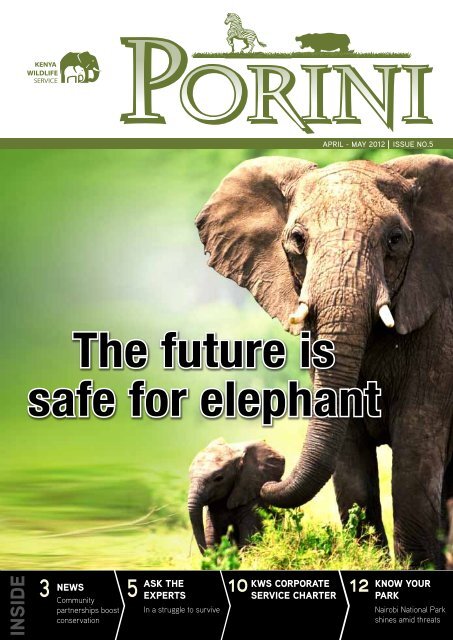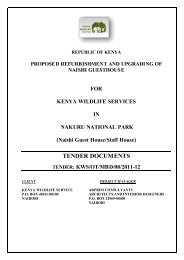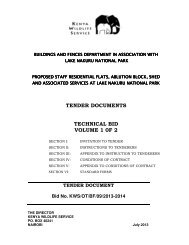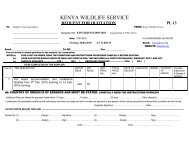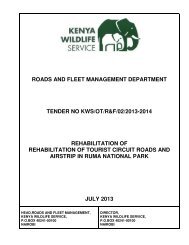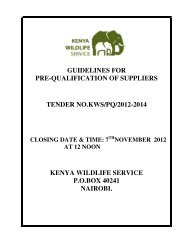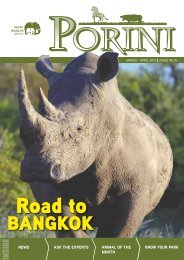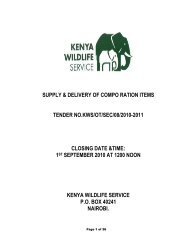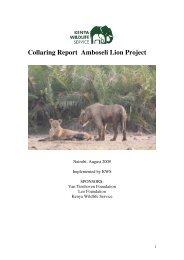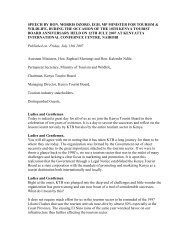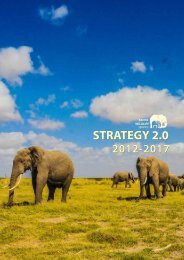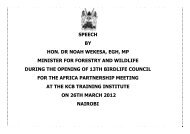Porini Issue No.5 April-May 2012 - Kenya Wildlife Service
Porini Issue No.5 April-May 2012 - Kenya Wildlife Service
Porini Issue No.5 April-May 2012 - Kenya Wildlife Service
- No tags were found...
Create successful ePaper yourself
Turn your PDF publications into a flip-book with our unique Google optimized e-Paper software.
APRIL - MAY <strong>2012</strong>ISSUE NO.5The future issafe for elephantSAFARI CARD NEWS 3 ASK THE 3 KWS CORPORATE 3 Know your 3ANIMAL OF THE ASK THE EXPERTS conservationCommunityEXPERTSSERVICE CHARTER parkMONTHEnjoy the wild partnerships with the boost In a struggle to survive Championing the fight Turning communities Nairobi National into 1 Parknew Safaricard conservation The Mountain Bongo against Rinderpest partners shines amid threatsINSIDE3 5 10 12
NewsEvents CalendarCommunity partnershipsboost conservationArticle by: SAMMI NDERITUWorld Health Day<strong>April</strong> 7, <strong>2012</strong>UN Earth Day<strong>April</strong> 22, <strong>2012</strong>World Heritage Day<strong>April</strong> 18, <strong>2012</strong>International Day for BiologicalDiversity<strong>May</strong> 22, <strong>2012</strong>Julius Kipng’etich, KWS Director, lays a foundation stone for the construction of classrooms for OlkeriPrimary School in Narok North.In 2011, the <strong>Kenya</strong> <strong>Wildlife</strong> <strong>Service</strong>(KWS) dedicated the year to servingcommunities. Julius Kipng’etich, KWSDirector, looks back and points out anotable achievement. “As we dedicatedlast year to serving communities, wenoted a dramatic reduction in conflict bycommunities against wildlife. In caseswhere wildlife destroyed crops, variouscommunities dealt with the problemamicably without resorting to killing theanimals.”In serving communities, KWS choseto focus on three main areas; water,education and health. “We built severalschools, health facilities and water projectsaround the country. This boosted ourrelationship with communities and led to amajor reduction in killing of wildlife,” saysKipn’getich.Besides the focus, KWS undertookother projects that were informed bycommunity requests. “The warden had theauthority to discuss with the community inhis/her area on their needs before makinga decision on the project to be undertaken.”The Director explains that KWS wascareful not to duplicate other projects thatwere going on the ground initiated by otherorganisations. In undertaking projects,KWS was driven by the need to add valueto the community.The Director believes that thepartnership with communities has resultedin a very strong foundation and pointsout that KWS will continue to engagecommunities since they are critical inenhancing conservation.World Migratory Bird Day<strong>May</strong> 9-10, <strong>2012</strong>World Turtle Day<strong>May</strong> 23, <strong>2012</strong>3
NewsRuma becomes new rhino sanctuaryArticle by: Patrick OmondiTwenty one black rhinos havebeen successfully reintroducedinto Ruma National Park inWestern <strong>Kenya</strong> making Ruma thenewest Rhino Sanctuary in <strong>Kenya</strong>.Ten of the rhinos were sourced fromMugie Rhino Sanctuary, in Northern<strong>Kenya</strong> where insecurity has led theGovernment to destock it of all herrhinos while the remaining elevenrhinos were sourced from SolioRanch, Central <strong>Kenya</strong>.These founder numbers of rhino inRuma will be kept safe and let to breedto increase in numbers for restockingother areas in future. The Introduction ofrhinos in this region is envisaged to alsoenhance and unlock tourismpotential in the region.The translocation of therhinos was carried out by the<strong>Kenya</strong> <strong>Wildlife</strong> at a cost of Kshs6 million.<strong>Kenya</strong>’s National blackrhino populations currentlystand at 620 from a low 380 in1985. The current <strong>Kenya</strong> rhinoconservation and managementstrategy envisage managingand conserving the black rhinoas a flagship species to reacha total of 750 by 2016 witha vision of 2000 black rhinos in theirnatural habitat.Simple steps towards conservation<strong>Wildlife</strong> and environmental conservationis a duty to each one of us.Here are some simple steps that you cantake to conserve wildlife.• Share what you know about theenvironment and what can be done tohelp save endangered species to yourfriends and family.• Do not buy products made from wildanimals and exotic hard woods! Ifpeople do not buy products made fromwild animals, the people who huntand trap wild animals will have to stopmaking the products. Products madefrom exotic hard woods often comefrom the rainforest that is home tomany endangered animals. Ask if youare not sure what a product is made ofand where it comes from.• Do not buy live animals that havebeen taken from the wild. When evenone animal is taken from the wild itencourages trappers to catch more.This includes all animals: mammals,reptiles, amphibians, birds, fish, andeven insects. If you would like an exoticanimal for a pet, ask the seller if it wasbred in captivity and have them showyou proof.• Work with and support environmentalorganizations. You can supportorganizations through donations ofmoney, materials, and your time.• Plant a tree. Trees provide shelterand food to animals. Trees also helpfight global warming caused by thegreenhouse effect, hold together soil,create shade, and make the world amore beautiful place.Avoid buying products made from wild animals and exotic hard woods!4
Ask the ExpertIn a struggle to surviveSea turtle populations are threatened throughout the world, and <strong>Kenya</strong> is no exception.Due to their unique ecology andmigratory nature, the myriad ofthreats sea turtles faces has led todrastic global population decline. PORINIspoke to Dr Charles Musyoki, a SeniorScientist at <strong>Kenya</strong> <strong>Wildlife</strong> <strong>Service</strong>, aboutthe animals’ conservation strategy.How many species of sea turtles arefound in <strong>Kenya</strong>?There are five species; the green turtle(Chelonia mydas), hawksbill turtle(Eretmochelys imbricata), olive ridley turtle(Lepidochelys olivacea) nest and foragewhile the loggerhead (Caretta caretta) andthe leatherback (Dermochelys coriacea)use <strong>Kenya</strong>’s waters as migratory routesand foraging grounds.Sea turtle populations are threatenedthroughout the world, and <strong>Kenya</strong> is noexception. The world population of seaturtles is estimated to have declined by 80per cent over the last 50 years, yet theyplay a critical role in the marine ecosystemand their presence is an indicator of thehealth of the marine environment. The seaturtle is thus one of the flagship speciesfor conservation, protection, research aswell as a tourism attraction in <strong>Kenya</strong>.What threats and challenges face seaturtle conservation?The main challenges that face sea turtleconservation include incidental captureduring fishing, coastal development andloss of habitat, and illegal exploitationfor their meat, oil and eggs. In addition,there is a lack of comprehensive dataand information on their population size,nesting and foraging sites, migration aswell as mortality and threats. The weightof the challenges facing the conservationof sea turtles is globally recognised, with<strong>Kenya</strong> having signed various internationaland regional agreements on sea turtleconservation and management.How can the recovery of sea turtles beachieved in <strong>Kenya</strong>?Effective management and recovery of<strong>Kenya</strong>’s sea turtle population can onlybe achieved through implementation ofa national strategy that was officiallylaunched in early 2011. This links intoregional and international initiatives toprotect nesting beaches and criticalforaging habitats from degradation,eliminate illegal harvesting and trade insea turtles and their products, mitigatefishing impacts and enhance collaborativeparticipation of local communities andother stakeholders in conservation.How will this strategy be implemented?The strategy is intended to guide effortsto conserve and manage sea turtles andtheir habitats in <strong>Kenya</strong>. The main tools tobe used towards its realisation includeadvocacy, communication, education,public awareness, targeted research andmonitoring and threat mitigation.This strategy builds on ongoingefforts and initiates changes that will addvalue to sea turtle conservation efforts.It is also aligned to international andregional conservation conventions andagreements. The strategy also contributestowards the realisation of Vision 2030,which recognises tourism as a majorsector towards economic empowermentand to the increasing international valueof eco-tourism in relation to speciesconservation.Besides <strong>Kenya</strong> <strong>Wildlife</strong> <strong>Service</strong> (KWS),which other institution is involved in theconservation of the sea turtles?KWS is working with the FisheriesDepartment (FiD). Both institutions havebeen mandated to conserve and managesea turtles and their habitats in <strong>Kenya</strong>’sterritorial waters.These organisations endeavour tocurb threats facing sea turtles, enlistingsupport in conservation, establishinginfrastructure and developing humancapacity. This progress has been madepossible by support from the Governmentof <strong>Kenya</strong>, local and international researchand conservation partners.KWS and FiD appreciate the inputand efforts of all stakeholders in theconservation and management of seaturtles. Successful implementation ofthe strategy will ensure that the speciespopulations and habitats are conserved.This requires the participation andcollaboration of all stakeholders: thegovernment, donors, the private sector,sea turtle conservation organisations andthe community.5
Cover StoryThe future is safe forelephantsBy: SAMMI NDERITUPhoto: KWSIn 1973, <strong>Kenya</strong>’s elephant populationwas 167, 000. By 1989, that had beenreduced to 20,000 due to massivepoaching for ivory. So severe was thepoaching menace that the governmentthrough <strong>Kenya</strong> <strong>Wildlife</strong> <strong>Service</strong> increasedsecurity efforts which significantlyreduced poaching. This was also boostedby the international ban on ivory trade in1989.<strong>Kenya</strong>’s memorable symbolism of thisban in ivory trade is that of a pile of ivorythat was set ablaze by former presidentDaniel Moi at the Nairobi National Park. By2010, <strong>Kenya</strong> was estimated to have about35,000 elephants.Poaching and ivory trade aside,elephants in <strong>Kenya</strong> continue to return toparts of their former range where theyhaven’t been seen for nearly 30 years.However, the human population in thecountry has increased dramatically overthis period and the challenge of conservingelephants today is quite different to what itwas 20 to 30 years ago.The elephant range in <strong>Kenya</strong> coversalmost a fifth of the country, of whichalmost half is within protected areas. Thesubsequent increase in elephant numberscoupled with loss and fragmentation ofelephant range as a result of increase inhuman population and limited long-termland use has brought new managementchallenges.These challenges arise from conflictsbetween people and elephants as theycompete for limited resources. Theresult is habitat loss for elephants dueto confinement. These are some ofthe factors that threaten the future ofelephants in <strong>Kenya</strong>.These problems have presentedenormous challenges to KWS and otherconservationists. Although there havebeen efforts to address these issues,recent reports and happenings point to anupsurge in elephant poaching. The highdemand of ivory and its products in Asiais largely fueling illegal trade, mostly inAfrica. In <strong>Kenya</strong>, recent large seizures ofivory at the sea and airports epitomise thescale of the problem.The world is witnessing increasedillegal killing of elephants. Thesophistication and the level of organisationof illegal traders in ivory are worrying.“Last year, <strong>Kenya</strong> lost 278 elephants topoachers compared to 177 in 2010. At thesame time, more than eight tonnes of ivoryhave been seized over the last three yearsillegally traded by our law enforcementofficers,” says Dr Noah Wekesa, Minister,Forestry and <strong>Wildlife</strong>.These are some of the reasons thathave necessitated the need for a dedicatedelephant conservation and managementstrategy. KWS in partnership with variousstakeholders has officially launched anelephant conservation strategy. This wasdone in February <strong>2012</strong> at the symbolicivory burning site.The 10-year strategy, aimed atsecuring the future of elephants in <strong>Kenya</strong>,has been developed through a highlyconsultative and participatory processthat involved both local and internationalexperts.The long-term vision for the strategyis a “secure future for elephants and theirhabitats based on peaceful and beneficialco-existence with people now and forgenerations yet to come.”The overall goal for the next 10 yearsis to “maintain and expand elephantdistribution and numbers in suitable areas,enhance security to elephants, reducehuman-elephant conflict and increasevalue of elephants to people and its habitat.“The strategy is bold, ambitious andforward thinking and tackles problemsfar more complex than just the poachingissue. It involves different sectors andproposes interdisciplinary initiatives thattake into consideration the potential roleof climate change, new emerging fundingopportunities, local livelihoods and thesensitive balance that is needed in anemerging economy,” says Patrick Omondi,head of species, KWS.“This document lays the foundation forsecuring the future of the elephants forposterity not only in <strong>Kenya</strong>’s celebratedheritage but the world’s. Implementingthis strategy is not going to be easy giventhat <strong>Kenya</strong>’s human population is growingfast and thus ethical solutions need to befound for humans and elephants to coexistas they have done over millennia,” saysJulius Kipng’etich, Director, KWS.Kipng’etich further says <strong>Kenya</strong> alonecannot conserve elephants and calls forThere is need to protect elephant populations by minimising poac6
Cover Storyregional co-operation as an importantfactor for the survival of the Africanelephant to increase the numbers, securemore space and minimise human-elephantconflict.“We will work closely with otherelephant range countries on variousCITES matters and also diplomaticallyengage with consumer countries.”The Convention on International Tradein Endangered Species of World Faunaand Flora (CITES), and the Conventionof Migratory Species of Wild Animals(CMS), are some of the international legalframeworks that are used in conservationand management of African Elephantsand other wild animals.CITES is an agreement betweengovernments and recognises thatinternational co-operation is essential forthe protection of certain species of wildfauna and flora against over-exploitationthrough international trade.CMS on the other hand aims atconserving terrestrial, marine and avianmigratory species throughout their range.<strong>Kenya</strong> is a signatory to CITES and theCMS. Therefore, the launched elephantsconservation and management strategyhas been developed while reflecting onthe provisions of CITES and CMS.<strong>Kenya</strong>’s population of Africanelephants is listed in Appendix 1 of CITESand Appendix II of CMS. Under CITESAppendix I, species are threatened withextinction, which are or may be affected bytrade while under Appendix II of the CMS,species are migratory that need or wouldsignificantly benefit from internationalcooperation.“The strategy’s vision and overall goalwill be achieved by focusing efforts andresources on the following seven broadstrategic objectives, each associated witha set of specific actions and measurabletargets to gauge performance,” explainsOmondi.These are;Protection: The need to protect elephants’populations by minimising poachingthrough effective law enforcementmeasures and stakeholder collaboration.Population expansion and habitatmaintenance: Maintain and expandelephant distribution and numbers insuitable habitat where appropriate.Research and monitoring formanagement: Strengthen existingmonitoring systems and conduct priorityresearch to provide information foradaptive management and protection ofelephants and critical habitats.Human elephant conflict (HEC): EnhanceHEC mitigation by involving stakeholdersat all levels in the use of appropriate sitespecific methods.Incentives: Provide benefits thatwill encourage landowners and localcommunities to tolerate, protect andaccommodate elephants.Capacity: Sustain an effective resourcecapacity through collaborative effortsamong stakeholders with a strategic focuson priority areas.Coordination and support: Implementan effective coordination frameworkto support stakeholders and enhancedecision making and action.In actualising these objectives, thestrategy provides a clear roadmap andrecognises the need to win space forelephants in areas that have not beenencroached by settlements and farms.“It also recognises the need to offerincentives and the provision of tangiblebenefits directly linked to the presence ofelephants to communities around elephantrange areas. This will increase toleranceand custodianship of elephants amongpeople that own and use land outsideprotected areas,” notes Wekesa.The strategy also stipulates the offeringof incentives and provision of tangiblebenefits directly linked to the presence ofelephants, which will increase toleranceand custodianship of elephants amongpeople who own and use land outsideprotected areas. This has been designedto encourage landowners and localcommunities to protect and accommodateelephants.The implementation of this strategy willcontribute significantly to the successfulrecovery of elephants’ populations in<strong>Kenya</strong>.hing through effective law enforcement measures and stakeholder collaboration.7
Photo GalleryPHOTOS: COURTESY KWSA KWS ranger reads theManagement InformationSystem (MIST) manual thatwill guide them in datacollection during patrolsand enhance variousmanagement tools inwildlife conservation.Mr. Juma Bakari (left) a warden at the Nairobi Animal Orphanage/NairobiSafari Walk ,receives a mounted lion cub picture from AFP photo journalist,Mr. Tony Karumba. The picture was Mr.Karumba’s gift to KWS.The Food and Agriculture Organisation (FAO) Director General, Jose da Silva, istaken through KWS fact sheets by the KWS Director, Mr. Julius Kipng’etich,during a courtesy call he paid to KWS.KWS Senior Assistant Director Community <strong>Wildlife</strong> <strong>Service</strong> Mr. MichaelKipkeu makes a presentation during an NGO’s partners meeting at theNairobi Safari Walk.Minister for Forestry and <strong>Wildlife</strong> Hon. Noah Wekesa hands over the NationalElephant Conservation and Management Strategy to the KWS Board ofTrustees Chairman, Hon. David Mwiraria at the Nairobi National Park IvoryBurning site where it was launched.Beach Management Programme personnel collect litter along the beachin Mombasa. The Programme aims at restoring <strong>Kenya</strong>’s coastal area as atourism destination while ensuring the marineand beach tourism products are preserved.8
PHOTOS: COURTESY KWSPhoto GalleryKWS Board of Trustees Chairman, Hon. David Mwiraria gets acquainted withthe e-Board system launched early this year. With him is the CEO of SoftwareTechnologies Ltd, Ms. Jyoti Mukherjee (left) and the KWS Head of ICT, Mr.Michael Odhiambo.KWS Director, Mr. Julius Kipng’etich receives a laptop from the Born FreeCountry Director, Mr. Iregi Mwenja. Born Free donated laptop computersworth USD 3000 to KWS for use in curbing poaching and bush meat trade.KWS Southern Conservation Area Assistant Director, Ms. Anne Kahihia,addresses the Maasai Community from Kitengela at a human-wildlifeconflict resolution meeting at Muchiriri Valley in Sholinge area early thisyear.Rangers from Tsavo Conservation Area lower the casket of their fallen colleaguewho was killed in an ambush at the Sagala Ranch in Tsavo Conservation Area.KWS veterinary officers attend to a rhino before its translocation to the KisumuImpala Sanctuary. The exercise is aimed towards protection of white rhino.Mr.Ajing Machok Ajing an officer with the Republic of Southern Sudan<strong>Wildlife</strong> <strong>Service</strong> listens to presentations during the course opening of atraining programme on <strong>Wildlife</strong> Management and Biodiversity Conservationat the <strong>Kenya</strong> <strong>Wildlife</strong> <strong>Service</strong> Training Institute (KWSTI) in Naivasha.9
Know your parkNairobi National Park shines amidthreatsArticle by: SAMMI NDERITUSeven kilometres from Nairobi’sbusy city centre, rhinos, lions,buffaloes, baboons, zebras, giraffesand wildebeests freely roam the expansivefields of the world’s only national park thatis located close to a capital city.Nairobi National Park was the first tobe gazetted in East Africa in 1946. It is 117sq.km and boasts of the big five animalsexcept the elephant. It is also a rhinosanctuary. Its other attractions include theanimal orphanage, Nairobi Safari Walk andthe ivory burning site monument.Though the park has been a sourceof pride in Nairobi, increasing humanpopulation, shrinking land and pollutionare a threat. As a result, there has beena decrease in the migration of animals toand from the park.“We used to experience a lot of animalmigrations such as wildebeests andzebras but because of human settlementbetween here and Amboseli National Park,that is no longer happening,” explainsMark Cheruiyot, Senior Warden, NairobiNational Park.Mostly, animals move out of the parkfrom the southern part which is not fenced.The eastern and western parts coveringMagadi road, Bamburi and Kitengela arefenced. There is need to prevent wildlifemovements in such areas that are busy,commercial and highly populated.At the moment, there is minimalmigration of animals to neighbouringareas like Isinya, Kitengela, Ole Polos andOngata Rongai. Nevertheless, the growthof these areas is suffocating the park andcutting off the dispersal routes.“This has led to increased cases ofconflict among humans, livestock andwildlife,” says Cheruiyot.Noting that wildlife is for all <strong>Kenya</strong>nsand thus the need to secure it, <strong>Kenya</strong><strong>Wildlife</strong> <strong>Service</strong> is currently undertakingvarious awareness and communityprojects in partnership with otherstakeholders.Through these projects, KWS hasreached out to various communitiesadjacent to the park through theestablishment of a consolation fund anddevelopment of land use plan. The fund ismeant to pay people whose livestock orcrops have been affected by wildlife fromthe park. At the moment, the law does notpermit the government to pay for propertydestroyed by wildlife except compensationpollution. Solid wastes from factories andresidential houses find their way into thepark through several rivers. Some of thiswaste like plastic is non-biodegradable.Therefore, KWS has to incur extraexpenses in controlling and collecting thewaste. Furthermore, liquid effluent thatfinds its way into the park kills animals.“To deal with these challenges, KWShas to regularly do water quality andquantity monitoring of the three rivers thatflow into the park,” explains Cheruiyot.Nairobi National Park is positioning itself as part of <strong>Kenya</strong>’s Vision 2030 to be among the country’s leadingtourist destination sites.to human life or injuries.In addition to the fund, a land useplan known as Kitengela, Isinya, KipedoIntegrated Development Plan has beendeveloped and received ratification by theMinister of Lands.“The plan has been developed byNarok County Council with the help ofKWS and other players like InternationalLivestock Research Institute (ILRI) toidentify proper land use in this area so thatwe don’t just sub-divide land into smallpieces that have no use at the end of theday,” says Cheruiyot.The other challenge Nairobi NationalPark faces is pollution. The urban part ofthe park is currently experiencing heavyVision 2030Despite these challenges, Nairobi NationalPark is positioning itself as part of <strong>Kenya</strong>’sVision 2030 to be among the country’sleading tourist destination sites. KWS ispursuing mutual relationships with varioushotels to include the park as a package totheir products.“If visitors have a break for some time,other than spending the day in a roomwatching TV or sleeping, we can havethem visit the park,” says Cheruiyot.The marketing strategy also intendsto link the park with Jomo <strong>Kenya</strong>ttaInternational Airport that will see transitvisitors have brief tours of the park whilewaiting to connect flights.12
Ranger’s DiaryFor the love of treesVery few people in Mount Elgon were interested in planting trees when Ranger KevinJuma was posted there but an awareness he initiated has paid off as locals begun toaccept the seedlings and plant them in their farm. He tells Sammi Nderitu his story.“One day in 2006, I was travelingfrom my home area in Loiyangalani,Northern <strong>Kenya</strong> heading to Nairobi. Igot to Marsabit and a friend told me that<strong>Kenya</strong> <strong>Wildlife</strong> <strong>Service</strong> was conducting arecruitment exercise for rangers.I got interested and joined the groupof youth at the stadium and went throughthe process. At the end of the day, I wassuccessful and got my recruitment letter.After my paramilitary training atManyani Field Training School, I wasposted to Mount Elgon National Park. Theweather in Mt Elgon is totally differentfrom that in Loiyangalani. Whereas themountain area is cold and most of the landarable, my home area is a semi-desertdespite being near Lake Turkana.When I got here, I could not understandwhy the local community was cuttingdown trees and lacked interest in plantingthem despite having the seedlings and afavourable weather. Trees play a criticalrole in the environment by providingoxygen, conserving water, preserving soiland supporting wildlife among many otherbenefits.When KWS received funds from a nongovernmentalorganisation to undertakethe Mount Elgon Regional EcosystemsConservation Programme (MERECP), Ibecame actively involved and was madethe project coordinator. My responsibilitywas to make sure trees are planted bothin the park and outside.Very few people were interested inplanting trees and some even rejectedthem when I took seedlings to the villages.They instead preferred to plant maizeand other food crops. To deal with this,I had to initiate community awarenessprogrammes and educated the communityon the importance of trees. We alsotaught them how trees should be planted,spaced, the types of trees that are goodfor the area and how they should be takencare of.Thankfully, the awareness paid offslowly by slowly as the locals begun toaccept the seedlings and plant them in theirfarms. Previously, it was a challenge fora household to accept five tree seedlingsbut now, households are scrambling to getmore than 100 tree seedlings.By the end of last year, we had givenout over 70,000 tree seedlings. To preventoverreliance on KWS to give out seedlings,we have encouraged communities to plantthem in their own farms and this has alsobecome successful.As a ranger, it excites me to seecommunities take part in enhancingconservation through planting trees andplaying a role in wildlife conservation.The beauty of nature is intrees, hence communitiesshould strive to plant themand take care of them.When communities embracewildlife management andconservation, cases ofpoaching are considerablyminimised.Being a rangerI love being a ranger and I amglad that I got this job. I havefound satisfaction in it andmy colleagues have becomelike brothers and sisters tome. As a ranger, having agood relationship with yourworkmates is very important.They are the ones who willalways be with you in thecourse of your work.In enhancing my skillsand becoming better in myjob, I am in the process ofgetting back to school toundertake a degree course ina management field. I intendto do this through a distancelearning programme becausethe nature of my job will notallow me to be away from myRanger Kevin Juma.work station.As a husband and a father to a son,I am glad that my family has supportedme in my job, although many times I havehad to be away from home. I thank themimmensely for being supportive and veryunderstanding.To other rangers in Mt Elgon andelsewhere, continue being dedicatedto your job. Just like the late WangariMaathai’s story of the humming bird, youare like that small bird. Each one of ushas a role to play in conserving wildlife.Therefore, keep doing your best to takecare of wildlife.”14
<strong>Wildlife</strong> jokesWhat do you get whenyou cross a cheetah witha turtle?A speed limit.What does a leopard saywhen it claims an area?“This is my spot!”How can a leopardchange his spots?Move to another place.What do you call a beethat can’t make up itsmind?<strong>May</strong>bee.What do you call anelephant that eats toomuch?An elefat.What kind of hawk can’tfly?A tomahawk.What do you call acaterpillar that falls intoa volcano?Hot larva!What’s the richestanimal in the world?A diamondbackrattlesnake.How do cats keep theirbreath fresh?They use mouse-wash.What kind of music domonkeys like?Swing!How did the kangarooconvict escape?He jumped bail.What do you get if youcross an elephant with awhale?A submarine with a builtin snorkel.Talk to <strong>Porini</strong>, Do you have an article or an interesting photo to share? Email: porini@kws.go.ke• Follow <strong>Porini</strong> on: twitter@kwskenya/ Facebook: <strong>Kenya</strong> <strong>Wildlife</strong> <strong>Service</strong>15
Adventure.Fun. learnCity BreakUnwind at the only National Park within a Capital Cityin the World! Visit the Animal Orphanage, enjoy theserenity of the Nairobi Safariwalk and take a gamedrive or have a barbeque at the Nairobi National Park.See the varied vegetation from dry highland to riverineforest and rolling grasslands forming an intricateecosystem for over 80 animal and 400 bird species.Conservation FeeAdults: From 150Students & Kids:From Kshs 50For more information visit www.kws.go.ke, Facebook(<strong>Kenya</strong> <strong>Wildlife</strong> <strong>Service</strong>), Twitter (@kwskenya),You can also visit our social media profiles:www.kws.go.ke


